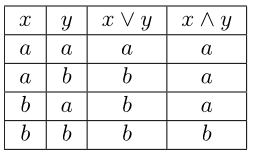Here are some additional examples of lattices.
A familiar example
Consider the following lattice.
Does this lattice look at all familiar to you? From some other area of mathematics, perhaps?
Reveal the truth
In fact, this lattice corresponds to boolean logic, as can be seen when we replace b with true and a with false in the following "truth table".
Normal subgroups
Let be a group, and let be the set of all normal subgroups of . Then is a lattice where for , , and .
Proof
Let . Then . We first note that is a subgroup of . For let . Since is a group, , and , we have . Likewise, . Combining these, we have , and so is satisfies the closure requirement for subgroups. Since and are groups, , and , we have and . Hence, , and so satisfies the inverses requirement for subgroups. Since and are subgroups of , we have and . Hence, we have , and so satisfies the identity requirement for subgroups.
Furthermore, is a normal subgroup, because for all , . It's clear from the definition of intersection that and do not share a common subset larger than .
For , we have .
First we will show that is a group. For , since , there is some such that . Hence, , and so is closed under 's group action. For , we have , and so is closed under inversion. Since and , we have . Finally, inherits its associativity from .
To see that is a normal subgroup of , let . Then .
There is no subgroup of smaller than which contains both and . If there were such a subgroup, there would exist some and some such that . But and , and so from 's group closure we conclude , a contradiction.

